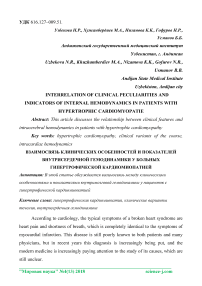Interrelation of clinical peculiarities and indicators of internal hemodynamics in patients with hypertrophic cardiomyopatie
Автор: Uzbekova N.R., Khuzhamberdiev M.A., Nizamova K.K., Gofurov N.R., Usmanov B.B.
Журнал: Мировая наука @science-j
Рубрика: Основной раздел
Статья в выпуске: 4 (13), 2018 года.
Бесплатный доступ
This article discusses the relationship between clinical features and intracerebral hemodynamics in patients with hypertrophic cardiomyopathy
Hypertrophic cardiomyopathy, clinical variants of the course, intracardiac hemodynamics
Короткий адрес: https://sciup.org/140263485
IDR: 140263485
Текст научной статьи Interrelation of clinical peculiarities and indicators of internal hemodynamics in patients with hypertrophic cardiomyopatie
According to cardiology, the typical symptoms of a broken heart syndrome are heart pain and shortness of breath, which is completely identical to the symptoms of myocardial infarction. This disease is still poorly known to both patients and many physicians, but in recent years this diagnosis is increasingly being put, and the modern medicine is increasingly paying attention to the study of its causes, which are still unclear.
In cardiology, this syndrome became widely known in 2006 after discussion of this topic at the European Congress of Cardiology in Barcelona. Nevertheless, many practical doctors remain poorly informed about its existence.
In cardiology, it is believed that the syndrome of a broken heart, or stress-induced cardiomyopathy (it is also a reversible apical dyskinesia) is caused by strong emotions and characterized by a transient disruption of the left ventricle of the heart, which manifests itself by changes in the electrocardiogram and in the blood that are characteristic of myocardial infarction. Despite the initially difficult condition of the patients, almost all of them completely recover within a few days or weeks without any complications.
Provoking this disease is a strong stress and intense emotional experiences. Almost immediately afterwards, severe pain in the heart and serious breathing problems occur in the patients, which is usually diagnosed as myocardial infarction, since the symptoms and data of the electrocardiogram do not cause any doubt. The chest pains with this syndrome are longer than with myocardial infarction.
With this disorder, the heart of the patients, or rather his left ventricle, takes an unusual shape. It seems to be crushed by an invisible hoop. This symptom helps distinguish this disorder from a heart attack and correctly diagnose it.
Stress-induced cardiomyopathy was first described in 1991 in Japan and was even called taco-zubo by the name of an octopus trap, which is used by Japanese fishermen, since with this syndrome the shape of the left ventricle becomes similar to it. Very often this syndrome is called a broken heart syndrome.
Cardiology is aware of this disease very little. The mechanisms of its occurrence are unclear. The apparent connection of it with stress and heavy emotions makes doctors think that its cause lies in the effect of catecholamines - stress hormones. Dear readers, if you read this article not on the website of the Embassy of Medicine, then it is borrowed there unauthorized. Other mechanisms, such as coronary artery spasm, impaired microcirculation of the blood in the heart and neurological causes, have also been studied, but none of them has yet been confirmed.
The problem in diagnosing this disorder is that both blood tests and an electrocardiogram with a broken heart syndrome are almost identical to the results of diagnostic tests with myocardial infarction. To distinguish it is possible only through coronary angiography, which demonstrates in this case perfectly healthy arteries of the heart.
Exhaustive information about this disease, in which the results of the 14 most relevant studies of this syndrome are collected, was recently published in the journal European Heart Journal. It turned out that among stress-induced cardiomyopathy cases, approximately 2% of myocardial infarctions are accurate. In more than half of cases, this disorder is preceded by severe stress and catecholamine levels are elevated in 74% of patients. In comparison with the normal concentration of these hormones, in these patients it can be increased tens of times.
More than 90% of cases of this disease occur in women in menopause. The reason for this is unclear, but there are several hypotheses: a greater sensitivity of women to the action of stress hormones and problems in blood vessels and heart muscle, provoked by a low level of female sex hormones.
With stress-induced cardiomyopathy, emergency hospitalization of the patient in the cardiology department is necessary. This syndrome causes heart failure, which disappears without a trace in a few days. The prognosis of the disease is usually very good. Mortality is only 1.1%. In very rare cases, there may be severe complications: atrial fibrillation at 4.2% and cardiogenic shock in 1.5% of cases.
The stereotype of thinking in medicine so far is the unreasonable belief that women are supposedly more protected from the development of cardiovascular diseases due to the beneficial effect of estrogen, female sex hormones, on them. As vysnylos in recent studies on this subject, this is not entirely true. Despite the fact that these disorders in women do occur less often, but they have a much higher mortality rate for women than for men. In women, it continues to outweigh the mortality from all cancers combined.
Список литературы Interrelation of clinical peculiarities and indicators of internal hemodynamics in patients with hypertrophic cardiomyopatie
- Medicus.ru: http://www.medicus.ru/cardiology/specialist/sindrom-razbitogo-serdca-ili-stress-inducirovannaya-kardiomiopatiya-sindrom-tako-cubo-33873.phtml
- Ziegler D., et al. Exp.Clin.Endocrinol diabetes.-2009.-vol.107.-P.421-4
- Lewiecki E.M. Fracture Risk Assessment in Clinical Practice: T-scores, FRAX, and Beyond. ClinicRevMinerMe-tab. - 2010. - № 8. - Р. 101-112.


